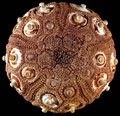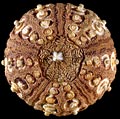The Echinoid Directory
Cidaris Leske, 1778, p. 74
[=Dorocidaris Agassiz, 1869, p. 254, type species Cidaris papillata Leske, 1778, p. 61 (=Echinus cidaris Linneus, 1758); =Orthocidaris Agassiz, 1863, p. 17, type species Cidaris papillata Leske, 1778, p. 61 (=Echinus cidaris Linneus, 1758) [non Orthocidaris Cotteau, 1862, p. 364] ]
| Diagnostic Features |
|
|---|---|
| Distribution | Recent, Atlantic. |
| Name gender | feminine |
| Type | Echinus cidaris Linneus, 1758, p. 664, by subsequent designation of Mortensen, 1910, p. 118. |
| Species Included |
|
| Classification and/or Status |
|
| Remarks |
|





